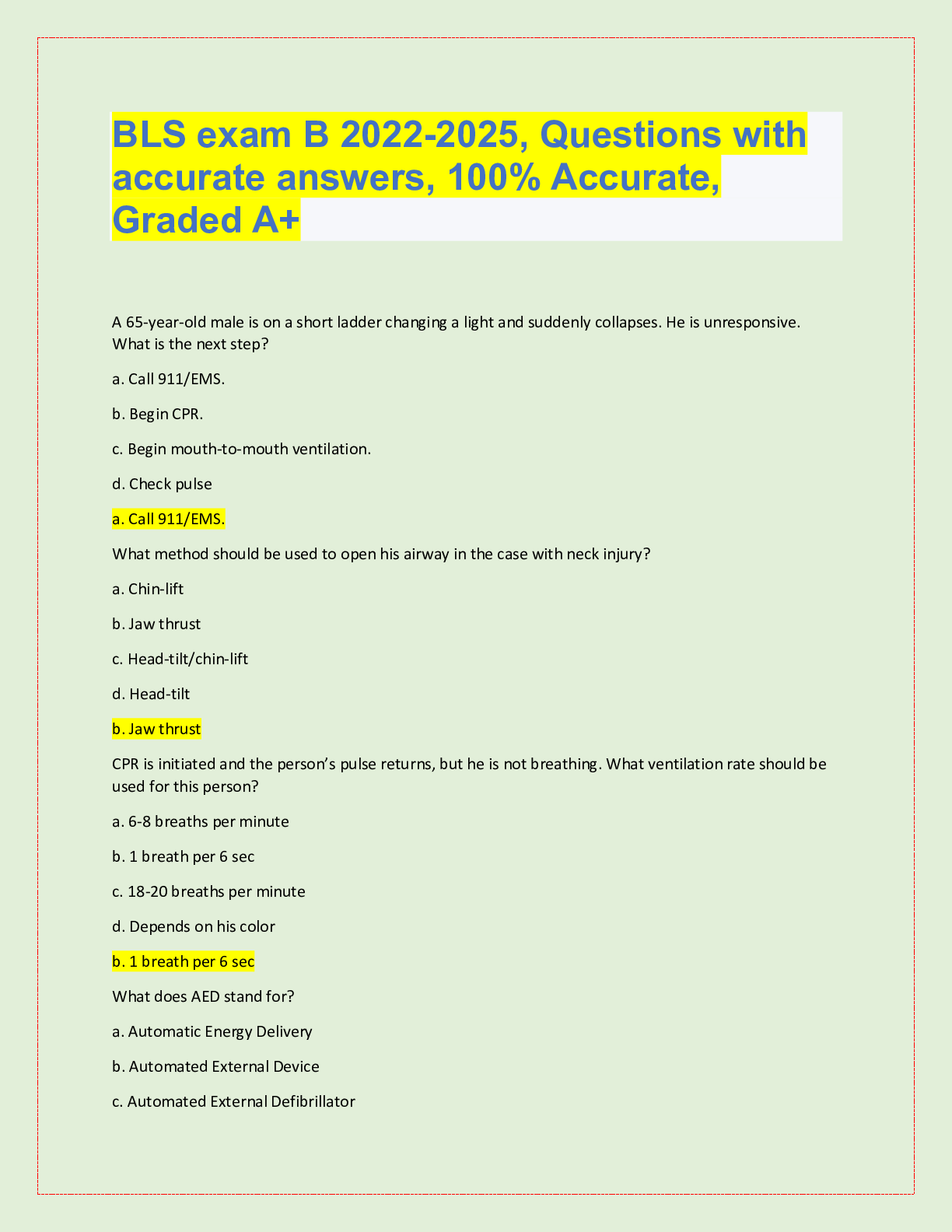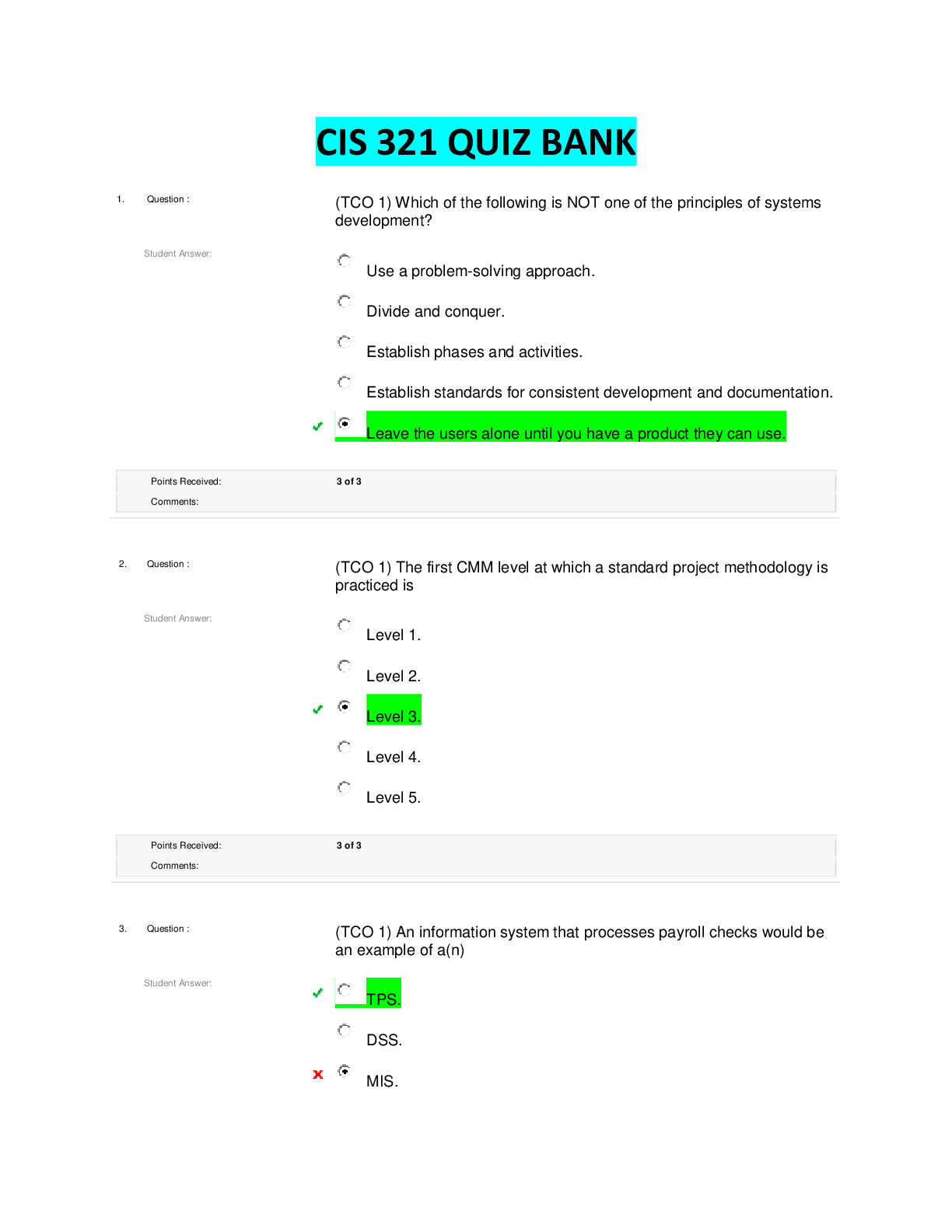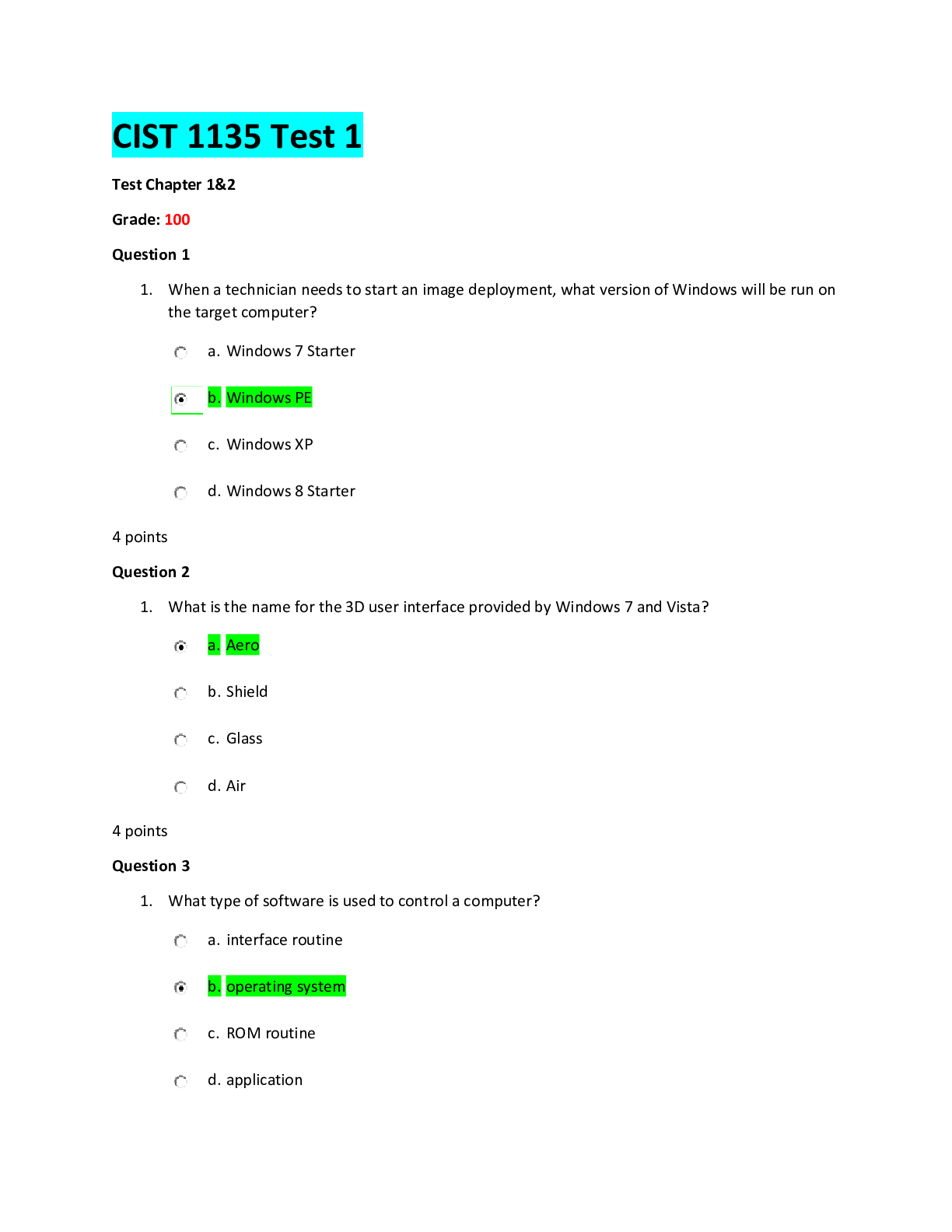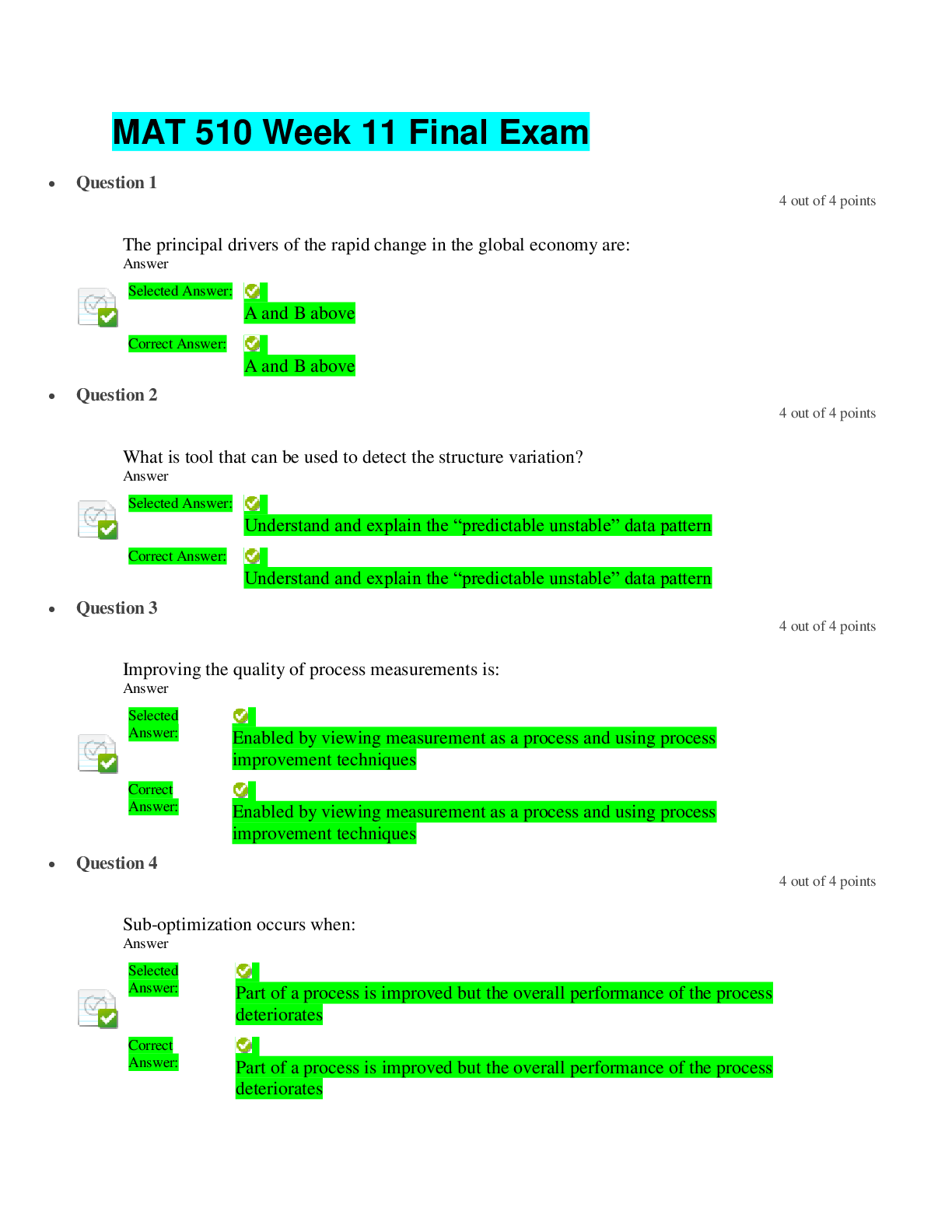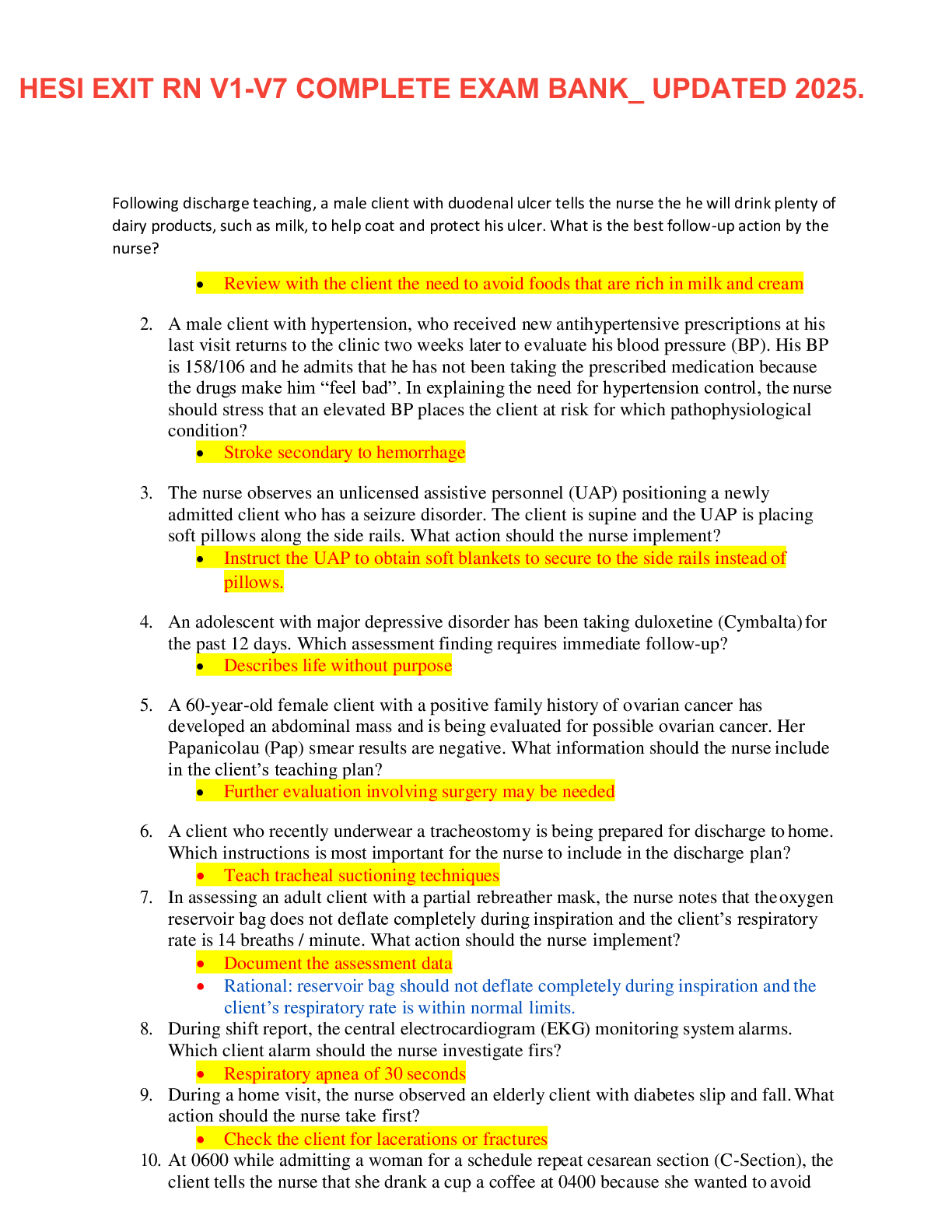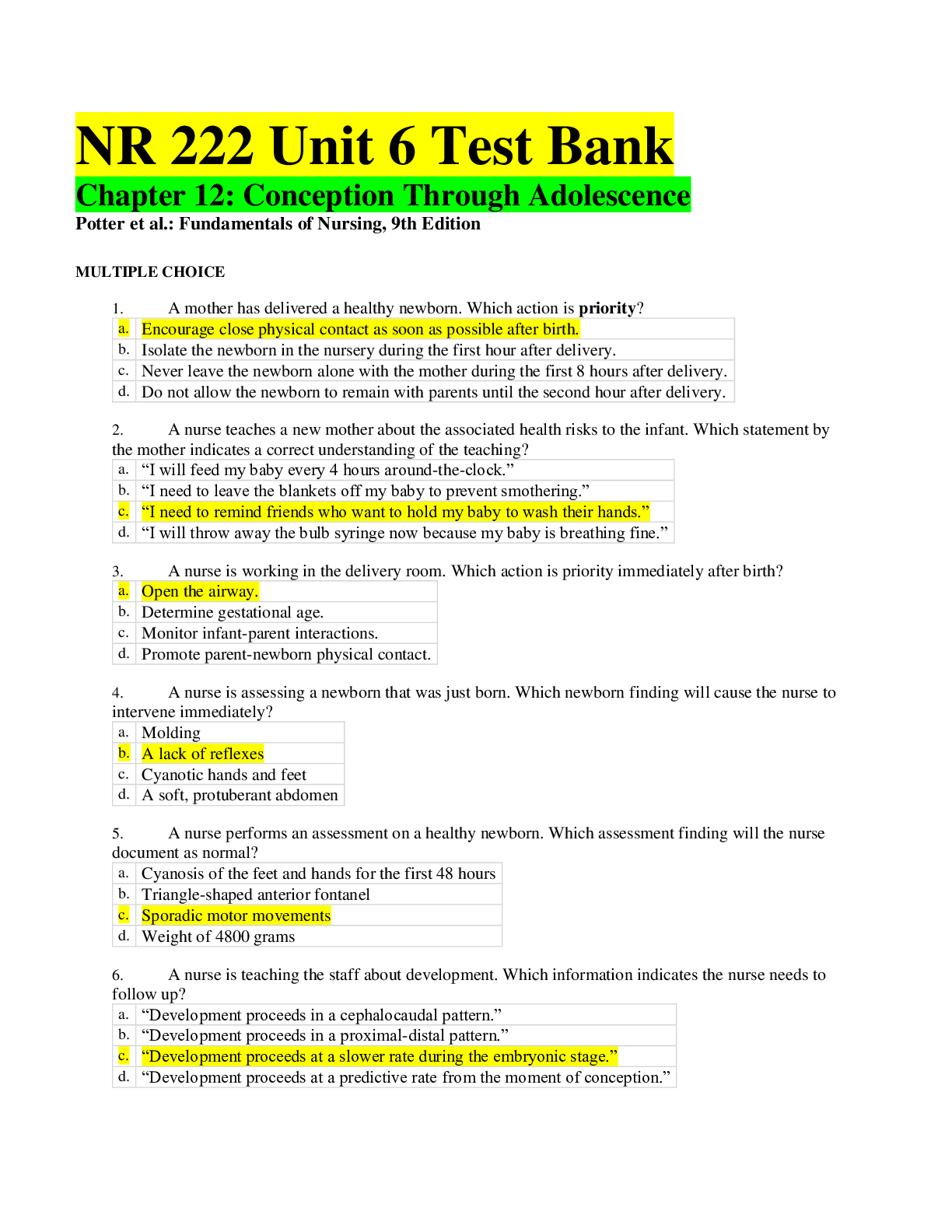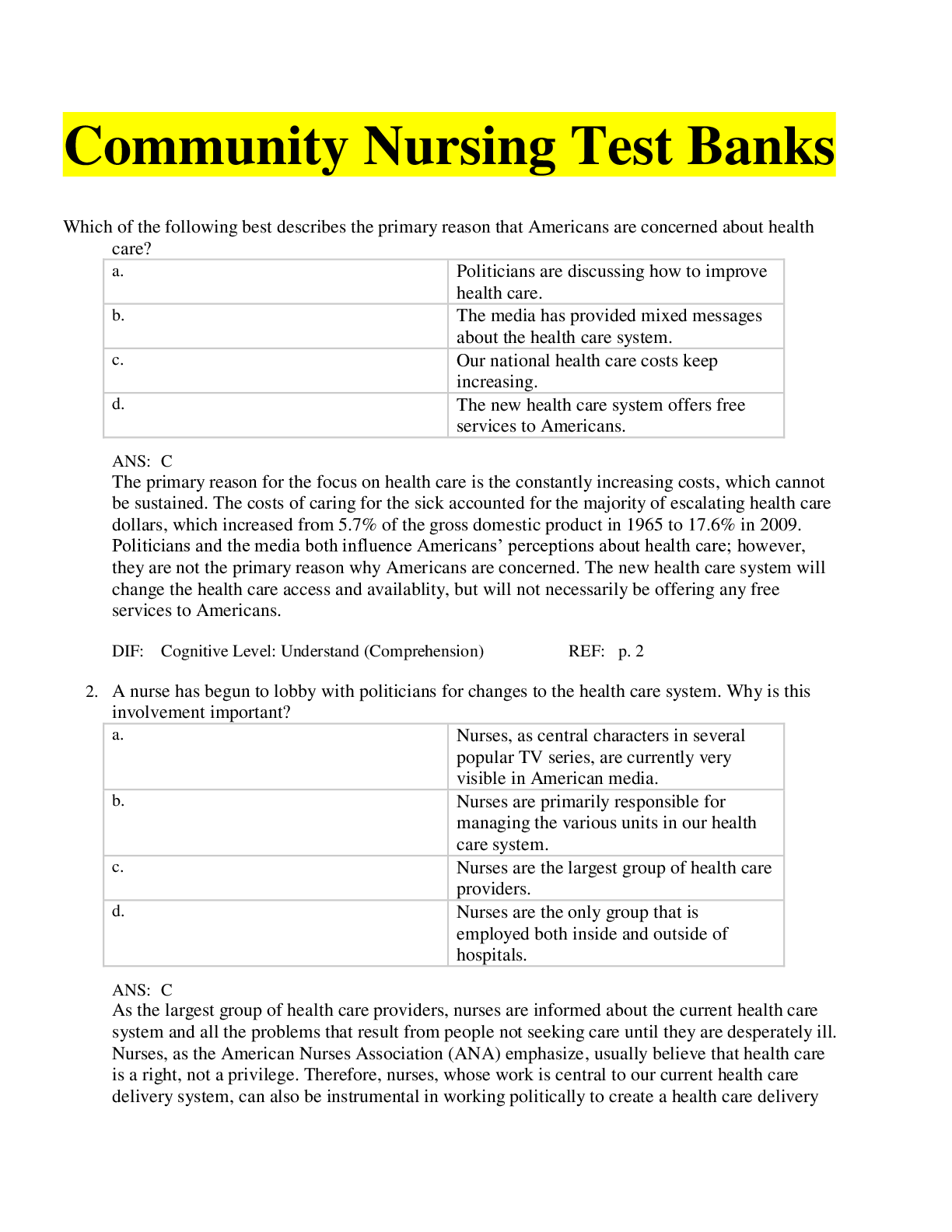Safety Management > QUESTIONS & ANSWERS > NRCME DOT Examiner Test Practice Questions & Answers, latest Version. Updated (All)
NRCME DOT Examiner Test Practice Questions & Answers, latest Version. Updated
Document Content and Description Below
NRCME DOT Examiner Test Practice Questions & Answers, latest Version. Updated According to FMCSA regulations, which of the following must the medical examiner evaluate when examining a driver's... eyes? A. Pupil reactivity B. Iris symmetry C. Conjunctival injection D. Corneal thickness - ✔✔Correct Response: A. Pupil reactivity Incorrect Responses: B. Iris symmetry This is incorrect because determining iris symmetry is not required by FMCSA. C. Conjunctival injection This is incorrect because most causes of conjunctival injection would not be disqualifying. Causes that are suspicious for a disqualifying condition need additional evaluation. While this abnormal finding should be explained, with determination of possible effects on safe driving before making a certification decision, it is not a condition that is specified in FMCSA regulations. D. Corneal thickness This is incorrect because it is not measured in an office examination except by an eye specialist. According to FMCSA regulations, medical qualification for two years can be given to a driver who has... ? A. An SPE certificate for a left below the knee amputation (BKA). B. Hypertension. C. A recent diagnosis of Lewy body dementia. D. Documented medical marijuana use for pain control. - ✔✔Correct Response: A. An SPE certificate for a left below the knee amputation.This is the correct response because in order to obtain the SPE certificate, the driver had to demonstrate the ability to perform all tasks for the commercial driver job description. Incorrect Responses: B. Hypertension. This is not the correct response because drivers with hypertension are only given a medical certificate that is good for one year. C. A recent diagnosis of Lewy body dementia. This is not the correct response because this is a progressive, degenerative condition with no known treatment. The effects of Lewy body dementia impact the ability to operate a CMV safely. D. Documented medical marijuana use for pain control. This is not the correct response because marijuana remains a drug listed in Schedule I of the Controlled Substances Act. It remains unacceptable for any safety-sensitive employee subject to drug testing under the drug testing regulations of DOT to use marijuana. Also, FMCSA medical guidelines state that "driving impairment due to marijuana use is well substantiated." During his visit to the medical examiner, a driver complains of severe pain in his finger for the last two weeks after it was punctured. The examination reveals an infected, swollen finger. After the medical examiner inquiries, the driver states that the pain is made worse when he grips the steering wheel. Which of the following should the medical examiner do next? A. Obtain a hand X-ray. B. Assess capillary refill in the hand. C. Obtain a culture and sensitivity. D. Assess the driver's grip strength. - ✔✔Correct Response: D. Assess the driver's grip strength.This is the correct response because the condition does not present a safety risk unless it interferes with the ability of the driver to hold and control the steering wheel. Incorrect Responses: A. Obtain a hand X-ray. This is not the correct response because this is a diagnostic test that a healthcare provider or specialist would perform or order. Your role as a medical examiner is to determine if the condition interferes with the ability of the driver to safely operate a CMV. B. Assess capillary refill in the hand. This is not the correct response because given the information in the question it is not the primary consideration for determining if the driver can safely operate a CMV. C. Obtain a culture and sensitivity. This is not the correct response because this is an action that a treating healthcare provider or specialist would do in the course workup and treatment- Your role as a medical examiner is to determine if the condition interferes with the ability of the driver to safely operate a CMV. A new driver who had a myocardial infarction six months ago is certified after completing an acceptable exercise tolerance test and is cleared by a cardiologist. According to FMCSA guidelines, which of the following is recommended regarding recertification and exercise tolerance test monitoring intervals? Recertification / Exercise tolerance A. Every year / Every year B. Every two years / Every year C. Every year / Every two years D. Every two years / Every two years - ✔✔Correct Response: C. Every year / Every two years This is the correct response because according to FMCSA medical guidelines, when a myocardial infarction is part of the medical history, there is a significant increased risk for another myocardial infarction to occur within six months to a year; therefore, a maximum of one-year certification is the guideline. Myocardial infarction guidelines also recommend exercise tolerance testing at least every two years to demonstrate continued ability to safely operate a CMV. Incorrect Responses: A. Every year / Every year This is not the correct response because the FMCSA medical guidance is to obtain an exercise tolerance test every two years. In this question, there is nothing to indicate that more frequent testing is necessary. B. Every two years / Every year This is not the correct response because it reverses the guidelines. Even if you do not recall the recommendation, logically, one would eliminate this option because having the driver obtain a test every year and then waiting for up to a year to review the test results is not reasonable when unacceptable test results indicate the driver may not be able to safely operate a CMV. D. Every two years / Every two years This is not the correct response because the guideline is to recertify every year. Even if you do not recall the actual guideline, one would logically eliminate this option because this is the maximum recertification period for a driver who meets all qualification requirements. It is appropriate that a driver at increased risk for an incapacitating cardiac event should be monitored more frequently. A 46-year-old male driver presents for recertification. He has a history of chronic gastro esophageal reflux disease (GERD). He takes esomeprazole (Nexium) and over-the-counter cimetidine (Tagamet). He states that he feels fine, but has trouble finding foods that do not trigger his GERD when he is on the road. Which of the following should the medical examiner do first? A. Disqualify the driver until he has a nutritional consultation. B. Certify the driver and advise him to carry non-triggering foods in a cooler. C. Contact the driver's physician and request an upper GI study. D. Correlate the GI history findings with the abdominal examination. - ✔✔Correct Response: D. Correlate the GI history findings with the abdominal examination. This is the correct response because given the information in the question; a medical examiner would need to examine the driver before having sufficient information about the health of the driver to consider any of the other options. Incorrect Responses: A. Disqualify the driver until he has a nutritional consultation.This is not the correct response because until completion of the examination, there is insufficient information to make a certification decision. In addition, there is no regulation or medical guideline that requires a nutritional consultation in order to be certified. B. Certify the driver and advise him to carry non-triggering foods in a cooler. This is not the correct response because until completion of the examination, there is insufficient information to make a certification decision. C. Contact the driver's primary care provider and request an upper-GI study. This is not the correct response because until completion of the examination, one does not have sufficient information to make a referral decision. A 25-year-old female driver denies a history of any medical problems. She is a non-smoker who exercises regularly without symptoms. The medical examiner auscultates bilateral wheezes during the examination. The driver's SpO2 is 90 percent in the medical examiner's office. The rest of the examination is normal. The driver should be... ? A. Temporarily disqualified pending results of a cardiac workup. B. Qualified since she has no cardiac symptoms. C. Temporarily disqualified until further evaluation. D. Qualified because her O2 saturation exceeds the minimum. - ✔✔Correct Response: C. Temporarily disqualified until further evaluation. This is the correct response because the driver has a non-diagnosed respiratory or thoracic illness that might interfere with the ability to safely operate a CMV. The driver should not be certified until the etiology is confirmed and treatment has been shown to be effective, safe, and stable. Also, according to FMCSA medical guidelines, a SpO2 of less than 92 percent warrants obtaining an arterial blood gas analysis. Which of the following stages of hypertension calls for a medical certificate that expires in a year? A. Stage 1 B. Stage 3 C. Stage 2 D. Stage 4 - ✔✔A. Stage 1 Medical certificates for drivers with Stage 1 hypertension expire after a year. Stage 2 hypertension results in a one-time, three-month medical certificate. Stage 3 corresponds to a medical certificate, good for 6 months from date of examination if the reading is less than or equal to 140/90. Lastly, Stage 4 hypertension doesn't exist. The FMCSA provides exemption programs for which of the following? A. Vision and diabetes B. Vision and hearing C. Hearing D. Pulmonary disease - ✔✔A. Vision and diabetes FMCSA has two medical driver exemption programs: Federal Vision Exemption Program (established in 1998) and Diabetes Exemption Program (established in September of 2003). The medical examiner determines whether the driver would be otherwise qualified if accompanied by the Federal vision or diabetes exemption. As a result of the exemptions, the driver must have an annual medical examination for maintenance and renewal of the exemption. Which of the following colors is not necessary to be able to distinguish and recognize in traffic signals and devices? A. Blue B. Amber C. Red D. Green - ✔✔A. Blue Due to specifically the colors of a stoplight and most road signs, it is necessary for a driver to be able to recognize the colors amber, red, and green. Blue is not a necessary color to recognize in traffic signals and devices. Which of the following is a medical examiner required to inquire about from a driver with diabetes mellitus? A. If the driver uses incretin mimetic B. If the driver has glycosuria C. If the driver carries rescue glucose while driving D. If the driver routinely monitors his or her blood glucose level - ✔✔B. If the driver has glycosuria While all of the questions are recommended to ask, the only question that is necessary is to see if the driver has glycosuria (dip stick urinalysis). It is recommended, though, to ask about carrying rescue glucose while driving, using incretin mimetic, and routinely monitoring his or her blood glucose level. Which of the following is not a concern that predisposes commercial drivers to an increased risk of cardiovascular disease? A. Exposed to environmental stressors that are detrimental to the cardiovascular system B. Driving stressors can lead to increased neurosympathetic and adrenocortical catecholamine and cortisol release C. Obesity and a sedentary lifestyle increase the risk of such a disease D. Long hours and rotating work schedules - ✔✔D. Long hours and rotating work schedules Obesity and a sedentary lifestyle increase the risk of cardiovascular diseases. Driving stressors can lead to increased neurosympathetic and adrenocortical catecholamine and cortisol release. Also, exposed environmental stressors that are detrimental to the cardiovascular system. However, the long hours and rotating work schedules do not predispose a driver for increase [Show More]
Last updated: 2 years ago
Preview 1 out of 13 pages

Buy this document to get the full access instantly
Instant Download Access after purchase
Buy NowInstant download
We Accept:

Reviews( 0 )
$9.00
Can't find what you want? Try our AI powered Search
Document information
Connected school, study & course
About the document
Uploaded On
Mar 17, 2023
Number of pages
13
Written in
Additional information
This document has been written for:
Uploaded
Mar 17, 2023
Downloads
0
Views
110

